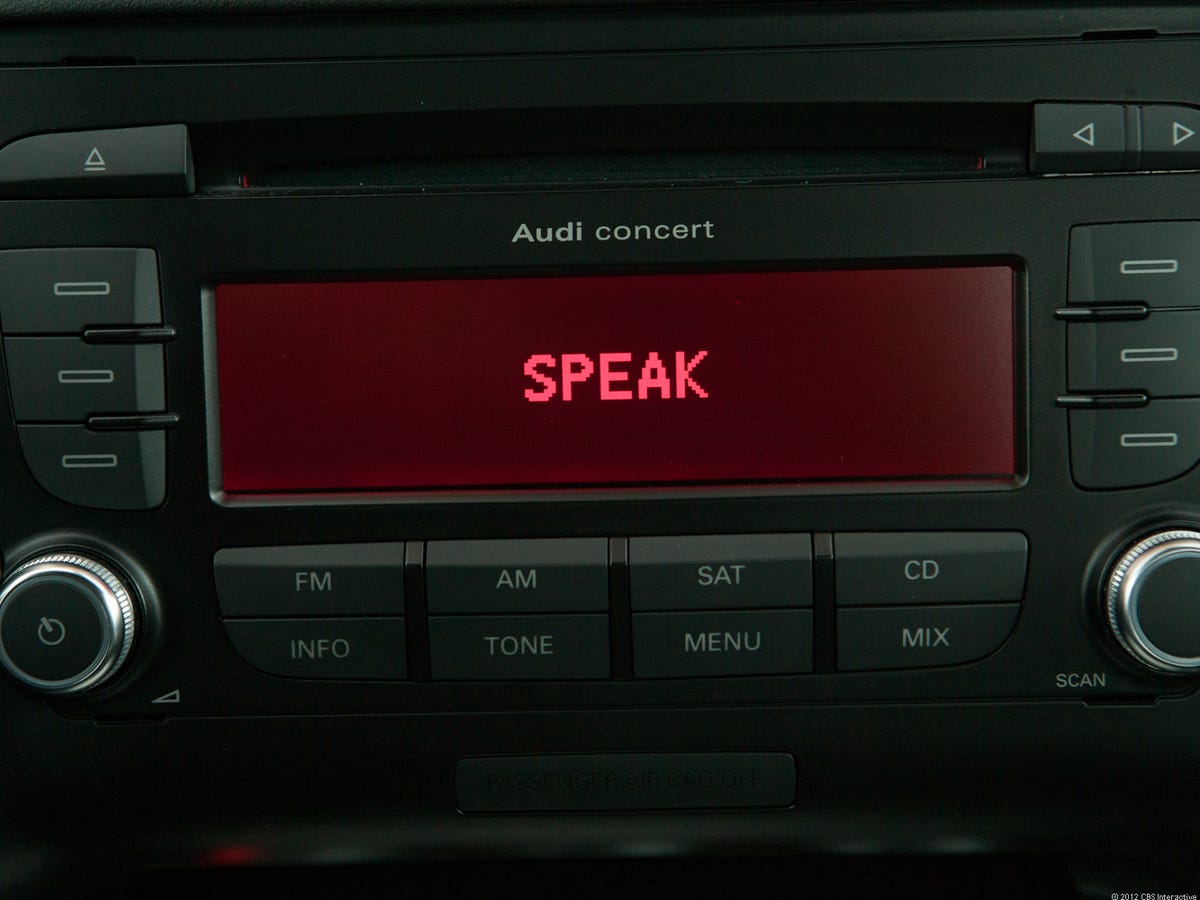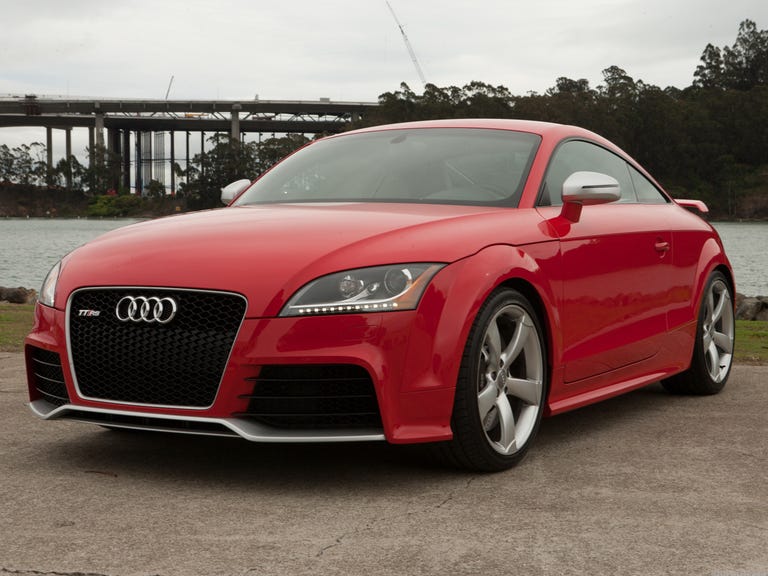 Why You Can Trust CNET
Why You Can Trust CNET 2012 Audi TT RS review: Audi TT RennSport suffers from model age
The powerful engine and excellent suspension of the Audi TT RS are offset by the inferior power-steering tuning and archaic cabin electronics, all attributable to the 6-year-old TT generation.
Whenever Audi releases an RS model in the U.S., car enthusiasts dance in the streets. These high-performance cars rarely make it here, so the excitement about the introduction of the 2012 Audi TT RS is understandable.
The Good
The Bad
The Bottom Line
But it is also a bit misguided, as Audi seems to have used its RennSport (RS) appellation to breathe just a little more life into a model long overdue for an update. The current TT generation launched in 2006, making the platform for the TT RS six years old.
The TT RS certainly exhibits exciting performance, a powerful engine combining with the dual handling threat of Audi's magnetic ride suspension and Quattro all-wheel drive. However, the steering tuning does not hold up its end of the handling bargain.
The most obvious example of the TT platform's age is the navigation option, which depends on maps stored on DVD. Using this system would have been like a time warp back to 2006, so I was not bothered that CNET's review car lacked this option. However, in the TT RS, Audi bundles the navigation system in with its MMI, or Multimedia Interface, integrating iPods and other digital audio sources with the stereo. Hence the missing navigation system also meant very few digital audio sources.
With its standard electronics package, the TT RS had a CD player and a radio, which at least included satellite. The car came standard with a very limited Bluetooth hands-free phone system, as well, but no Bluetooth audio streaming.
The tech package would have also brought in an upgraded audio system, but on paper, the nine-speaker base system should be adequate. However, this system wasn't robust enough to overcome the excessive road noise in the cabin. Audi seems to have stripped out some of the TT's sound-deadening materials for the RS model, which should lighten the car but also let in more outside noise.

From a purist standpoint, an Audi RS model does not need modern cabin electronics. But with a base price approaching $60,000, buyers will likely expect more than what the TT RS offers.
Four plus one cylinders
As a sports car, the TT RS recommends itself with a very powerful engine and enjoyable handling. The base TT goes for about $40,000, so what does the extra 20 grand get you? First of all, an extra cylinder. The TT RS hosts a 2.5-liter, five-cylinder engine under the hood, where the standard TT makes do with a 2-liter four-cylinder.
Better yet, direct injection and a turbocharger mean the TT RS' engine generates 360 horsepower and 342 pound-feet of torque. Not only should Audi be commended for wringing this much power out of a relatively low-displacement engine, but it is also a whopping amount for the 3,300-pound TT RS. Audi says the car makes it to 60 mph in 4.1 seconds.
Audi modulates the accelerator sensitivity with a Sport mode, activated by a button on the console. This button attempts to give the TT RS the same kind of dual character BMW has been so good at engineering into its models. But Audi is less successful here. In standard drive mode, the accelerator remains fairly touchy, and it is difficult to creep along in slow traffic without the occasional lunge forward. The idle also runs pretty low, making it easy to stall the car.
Sport mode makes the accelerator more enjoyable to use, but also harder to control at low speeds, again making a touch to the accelerator likely to induce a lunge. With the road clear ahead, however, the TT RS is in its element, delivering a powerful punch and showing almost no turbo lag. The more sensitive mode for the accelerator also makes it easy to modulate power when negotiating a turn at speed.
CNET's car came with an optional sport exhaust, also affected by the Sport button. In normal mode, the exhaust comes on with an impressive note, but press the Sport button and baffles open up in the exhaust. Suddenly, hitting the accelerator adds some bass burble to that growling exhaust note, enough to send the neighborhood cats running up trees and telephone poles.
Also helping to justify the TT RS' higher price is a standard magnetic suspension system. This brilliant system creates a magnetic field around the car's dampers, affecting a special fluid embedded with iron particles. Sport mode causes the magnetic field to stiffen the damper response, making the ride more rigid. Having encountered this type of adaptive suspension in a number of different vehicles, I can attest that it does an excellent job of making even larger cars corner like roadsters.
Given its short wheelbase and Quattro all-wheel drive, the TT RS doesn't need much help from its suspension. Rather, it seems Audi gave it the magnetic ride system to contribute to its dual character, allowing a softer ride in normal driving and tightening it up in Sport mode. In this regard, Audi is not all that successful. In normal drive mode, the TT RS provides a rigid, sometimes bone-jarring ride, never quite softening up to a comfortable-enough level for the daily commute.
In Sport mode, it gets even rougher, although with the added benefit of even better cornering. I reveled in the TT RS' ability to come around tight corners at speed with well-controlled rotation. At times it felt like a pole was driving through the center of the car, letting it pivot perfectly at the apex of a turn. The car displayed excellent grip at all times, the all-wheel-drive system throwing torque to the set of wheels needing it the most.
Six gears and a clutch pedal
Instead of Audi's famed DSG automated manual gearbox, the TT RS only comes with a six-speed manual. The DSG might have been truer to the hard-core performance signified by the RS label, but the six-speed manual should prove more enjoyable for people wanting the old-school engagement with the car afforded by working clutch pedal and shifter.
That said, I did not care for this shifter's action. The shift gate felt sloppy, and didn't deliver the kind of precise guidance into each gear I would expect from a European sports car. Maybe making up for the loose gate, Audi shows the currently selected gear on the instrument cluster display, along with an annoying icon suggesting upshifts to maximize fuel economy. Following the car's advice, I was in sixth gear at about 35 mph. The shift suggestions remain active even when the car is in Sport mode.
As much as I liked the power of the engine and the TT RS' handling, I found the steering very disappointing. Audi uses an electric power-steering system in the car, which was very obvious from the whirring sound when I turned the wheel while traveling at low speeds. At higher speeds, the boost lessens, adding more heft to the wheel, but the steering never feels as sharp or precise as I would want in a sports car. Going into each turn, the steering felt a little vague, and trying to make minor adjustments while taking a long turn at speed produced very little effect.
As Scion proved with the FR-S, electric power-steering systems can deliver excellent precision and allow for some road feel, so with the TT RS it may just come down to better tuning. What I would really like to see is a sport mode for the steering, enacting a little oversteer, that would be activated by a push on the Sport button.
The 2012 Audi TT RS suffers from its venerable platform in both the cabin electronics and the steering precision. Although the powerful engine and tight handling make for a good time on a mountain road, the imprecise steering limits how well you can control the car. And while the TT RS can be a lot of fun on the right roads, it would be an unruly daily commuter.
Bundling digital audio sources with a severely outdated navigation system makes for a tough choice when it comes to tech options. I would suggest waiting for an overall update to the TT, but that Audi would make an RS version in the future is far from assured. A good alternative for anyone considering the TT RS would be the 2013 Porsche Boxster, which comes in at the same price level and just received a major refresh.
| Tech specs | |
| Model | 2012 Audi TT |
| Trim | RS |
| Power train | Turbocharged direct-injection 2.5-liter 5-cylinder engine, 6-speed manual transmission |
| EPA fuel economy | 18 mpg city, 25 mpg highway |
| Observed fuel economy | 22.9 mpg |
| Navigation | Optional DVD-based system |
| Bluetooth phone support | Standard |
| Digital audio sources | Satellite radio, auxiliary input |
| Audio system | 140-watt 9-speaker system |
| Driver aids | None |
| Base price | $56,850 |
| Price as tested | $60,650 |


